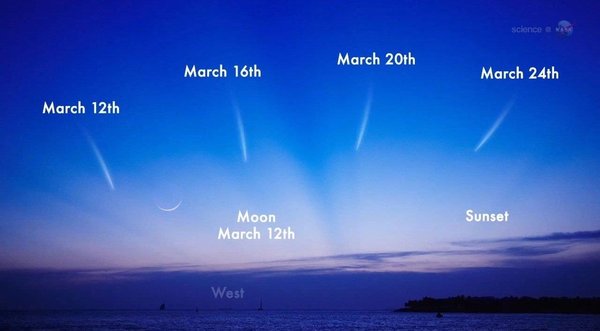When, Where and How to Watch the Comet PanSTARRS This Month
Look for the comet just after twilight in the Northern Hemisphere’s western sky, with the best viewing chances to come early next week
![]()

Comet PanSTARRS, seen here from Australia, will be visible in the Northern Hemisphere starting around March 6. Photo by stargazer Terry Lovejoy
This year is shaping out to be an exciting one for us to see chunks of rocks and ice as they hurl through space. We’ve had an asteroid the size of half a football field zoom within the paths of our orbiting satellites and a 10,000 ton meteor the size of a grey whale blow up over Russia. Now, Comet PanSTARRS is making its closest approach to Earth today and will be visible to observers in the United States starting later this week and through the middle of the March.
People in the Southern Hemisphere have been able to see PanSTARRS for weeks because its orbit was traveling below the celestial equator–the projection of Earth’s equator out into space. The comet hooks northward, crossing the celestial equator, on Thursday–look for it low in the western sky, just after sunset, for a few weeks thereafter.
Comets–balls of ice and dust–glow because heat from the Sun vaporizes ice. This direct change from ice into gas causes the comet to develop a coma–a large cloud of gas around its solid nucleus. The path of the coma through space creates two tails, a broad dust tail and a thin ion tail composed of gas molecules ripped apart by sunlight, both of which always point away from the Sun. Although each tail may be more than a million miles long–and PanSTARRS’s tails are sure to lengthen as they get closer to the Sun–they look short and stubby, according to Space.com. This tiny tail is likely an optical illusion that results from viewing the comet over a relatively bright twilight background, so astronomers recommend that you use binoculars or a small telescope to catch a better glimpse.
Officially called PanSTAARS C/2011 L4, so named because it was discovered by the University of Hawaii’s Panoramic Survey Telescope and Rapid Response System (Pan-STARRS) in 2011, the comet is now about 100,000 million miles from Earth. The “L4″ in its name stems from the fact that it was the the fourth comet discovered during the first half of June. But it’s the “C” that’s getting astronomers excited. This letter indicates that it’s a non-periodic comet, meaning that the icy body never has–and never again will–come close to the Sun.
Born from the Oort cloud–a giant spherical cloud at the edge of our solar system named after a 20th century Dutch astronomer–PanSTARRS and other comets like it hold dust and gases from our solar nebula’s earliest days, 4.5 billion years ago. And unlike Halley’s comet, which returns every 75 years, PanSTARRS’s upcoming trip to the Sun will be humanity’s only chance to see it.
The behavior of these types of comets is anyone’s guess. “Prepare to be surprised. A new comet from the Oort Cloud is always an unknown quantity equally capable of spectacular displays or dismal failures,” explained Naval Research Lab astronomer Karl Battams, according to a NASA video about the comet. “Almost anything could happen. On one hand, the comet could fall apart–a fizzling disappointment. On the other hand, fresh veins of frozen material could open up to spew…jets of gas and dust into the night sky.”
How bright will it be? Answering that question requires knowing how astronomers scale the apparent brightness of objects in the sky. Low numbers and negative numbers are the brightest. For example, the Moon’s brightness averages about -12.75. Sirius, the brightest star in our night sky, has a magnitude of -1.47 and the North Star’s magnitude varies, but hovers around +2. Under the best conditions, the faintest stars that humans can see without the aid of binoculars or telescopes is +6. Late last week astronomers were skeptical that PanSTARRS would get brighter than +2.2. But now, experts anticipate that the comet will be +1 or brighter when we attempt to scan the evening sky in hopes of viewing it.
PanSTARRS will likely be its brightest as it makes its closest approach to the Sun on March 10. At that time it will be just inside the orbit of Mercury–coincidentally, there will be no Moon in the sky to overpower its glow. And its glow–particularly its characteristic tails–is what viewers hope to see.

Comet PanSTARRS will be viewable to the unaided eye in the western sky just after sunset–on March 12 and 13, it will visible near a thin crescent moon, presenting a great photo opportunity. Artist rendition via NASA
PanSTARRS will show off its best photos ops on March 12 and 13 when the comet will appear close to the thin crescent Moon. As the Moon waxes in the days to follow, its brightness will make the comet look fainter.
Check out viewing tips, and be sure to catch viewing parties in your area. Let us know what you see!
Sign up for our free newsletter to receive the best stories from Smithsonian.com each week.
/https://tf-cmsv2-smithsonianmag-media.s3.amazonaws.com/accounts/headshot/mohi-kumar-240.jpg)

/https://tf-cmsv2-smithsonianmag-media.s3.amazonaws.com/accounts/headshot/mohi-kumar-240.jpg)